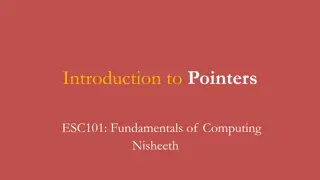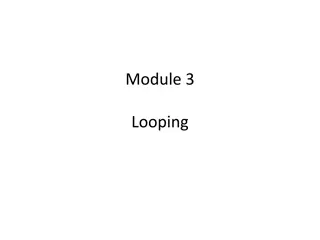Understanding Perl References and Pointers in High-Level Languages
Explore the concept of references in Perl, similar to pointers in languages like C and C++. Learn how references allow you to work with memory addresses and change variable values efficiently. Discover the basics of creating, using, and dereferencing references in Perl programming.
Download Presentation

Please find below an Image/Link to download the presentation.
The content on the website is provided AS IS for your information and personal use only. It may not be sold, licensed, or shared on other websites without obtaining consent from the author. Download presentation by click this link. If you encounter any issues during the download, it is possible that the publisher has removed the file from their server.
E N D
Presentation Transcript
Module 8 References
References In this last module of the course we will look at references. If you have programmed in C, C++, or other high level languages, you may be familiar with pointers, which are the same as Perl s references. If you have not seen these capabilities before, the learning curve is a little steep. To help show the abilities of references we have used very simple exercises throughout. This should show the basics of the subject without overwhelming you.
References Many high-level languages like C and C++ have the concept of a pointer, a variable that points to the memory address of another variable. Perl has pointers too, but they are called references. References do not hold a variable value, but hold the memory address of another variable. For example, if you have a variable called $num1, you could have a reference called $refnum1 which holds the memory address when $num1 has its data stored.
What is a reference Every variable in Perl has a value assigned in memory. Any value assigned to that variable is contained in that memory. For example, the statement: $num1=10; will have a memory location assigned with the name $num1, and a value of 10 is stored in that memory location. A reference is another variable, and has an assigned memory location, but holds the address of the $num1 memory location instead of a value.
Why use references Why bother using a reference to a memory location with a value in it? There are many reasons when you get into complex coding, but the simplest reason is it allows you to change the variable the reference points to (and hence the value it points to in that variable s memory location). This is very handy in some programs, as you will see. References are especially handy when dealing with arrays and lists
Creating a reference References are created exactly the same way as other variables, and have no special naming convention. To assign a value to the reference, you use the backslash: $refnum1=\$num1; This will create a reference variable called $refnum1which will hold the memory address of the variable $num1. Creating a reference to a variable doesn t affect the variable in any way.
Dereferencing To use the value a reference is pointing to, you have to tell the interpreter that you don t want to know the memory address it holds, but the value inside the memory address it points to. This is done with the dereferencing operator. For example: print $refnum1; will print the memory address $refnum1 holds, but print $$refnum1; will print the value in the memory address of $num1 (if that s what it points to).
Using references to change values You can use dereferencing to change the value of a variable the reference points to. This is done in the same way as looking up the value: $$refnum1=15; This command will change the value in the memory location $refnum1 points to and set the value of 15 there. You have to use two $ signs here: if you had written $refnum1=15; you would be setting the value 15 into the memory location of $refnum1, not the variable it points to.
Exercise Write a program that create a variable with a user-supplied value. Create a reference to that variable. Display the memory address of the reference and the value stored in the dereferenced variable.
Using reference values When a reference has been given a value (a memory location of a variable), the reference can be used with other variables and references. For example: $num1=10; $refnum1=\$num1; $refnum2=$refnum1; print $$refnum2; will have $refnum1 point to $num1. $refnum2 then is set to the same value, so the last line shows the dereferenced value of $refnum2, or 10.
References to references You can set up a reference to a reference, although you won t need this type of ability until you get into complex coding: $num1=10; $refnum1=\$num1; $refnum2=\$refnum1; the last line sets $refnum2 to the value of $refnum1 (the memory location of $num1), and not to $num1 directly. To dereference $refnum2 here and see the value of $num1, use: print $$$refnum2;
Exercise Write a program that sets up five scalars filled with numbers supplied by the user. Then, set up a reference variable that points to the first scalar. Display the dereferenced values of that variable, as well as the memory location it uses. Change the reference to each of the other four variables in turn and repeat the display process.
References to arrays You can set up a reference to an array in the same way as a reference to a scalar. Since the reference holds a memory address, it is a scalar itself and defined with a $: @array1=( 1 , 2 , 3 ); $refarray1=\@array1; The variable $refarray1 will have the memory address of the first element of the array @array1. It does not point to the entire array, just the start of the memory for @array1.
Dereferencing array references To dereference array references, you can reference any element in the array pointed to with the usual element subscript: $$refarray1[2]; This shows the value of the third element in whatever $refarray points to. If you want to see the whole array, use: @$refarray1; You can see a range of elements, too: @$refarray1[0-3]; shows the first four element in the array.
Exercise Write a program that prompts the user for five strings, and save them as elements in an array. Then, set a reference to that array. Use a loop to show each of the elements in that array using the reference, one element at a time.
References to hashes References to hashes are set up the same way as arrays: $refhash1=\%hash1; You access single elements in the hash through the hash key, and get the value associated with that key back: $$refhash1{key}; To see the whole hash the reference points to, use: %$refhash1;
Exercise Create a hash and a reference to that hash. You can either prompt the user for hash keys and values, or simply hardcode them to save time. Use a loop to display all the values associated with each hash key in the hash. You may have to refer back to Module 5 for the hash functions.
Passing references to subroutines One of the strengths of references is the ability to pass references to arrays and hashes to subroutines. This allows more than one array or hash to be passed properly to a subroutine. Since the code: sub twoarrays { (@array1, @array2)=@_; } does not work, as both arrays are joined into one array @_, references provide a way to pass scalars which reference more than one array.
Passing arrays To pass two arrays to a subroutine, you could do this: @array1=( ); @array2=( ); $refarray1=\@array1; $refarray2=\@array2; passarray($refarray1, $refarray2); sub passarray { statements } and both arrays can be used inside the passarray subroutine by dereferencing the references.
Exercise Create two arrays, one holding vowels and the other holding consonants. Pass both arrays into a subroutine using references. Inside the subroutine, display all the elements of each array.























